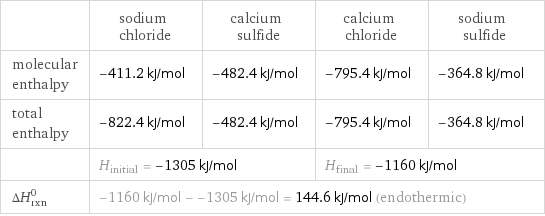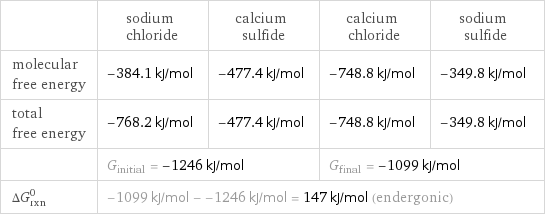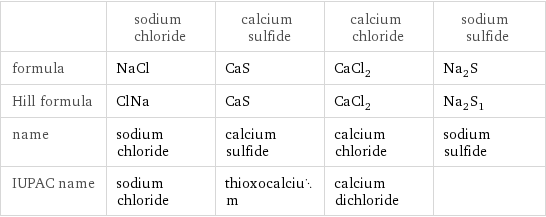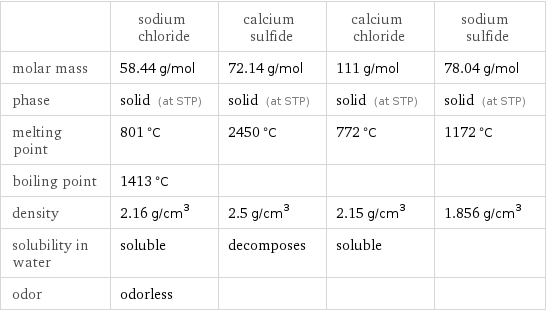Input interpretation

NaCl sodium chloride + CaS calcium sulfide ⟶ CaCl_2 calcium chloride + Na_2S sodium sulfide
Balanced equation

Balance the chemical equation algebraically: NaCl + CaS ⟶ CaCl_2 + Na_2S Add stoichiometric coefficients, c_i, to the reactants and products: c_1 NaCl + c_2 CaS ⟶ c_3 CaCl_2 + c_4 Na_2S Set the number of atoms in the reactants equal to the number of atoms in the products for Cl, Na, Ca and S: Cl: | c_1 = 2 c_3 Na: | c_1 = 2 c_4 Ca: | c_2 = c_3 S: | c_2 = c_4 Since the coefficients are relative quantities and underdetermined, choose a coefficient to set arbitrarily. To keep the coefficients small, the arbitrary value is ordinarily one. For instance, set c_2 = 1 and solve the system of equations for the remaining coefficients: c_1 = 2 c_2 = 1 c_3 = 1 c_4 = 1 Substitute the coefficients into the chemical reaction to obtain the balanced equation: Answer: | | 2 NaCl + CaS ⟶ CaCl_2 + Na_2S
Structures

+ ⟶ +
Names

sodium chloride + calcium sulfide ⟶ calcium chloride + sodium sulfide
Reaction thermodynamics
Enthalpy

| sodium chloride | calcium sulfide | calcium chloride | sodium sulfide molecular enthalpy | -411.2 kJ/mol | -482.4 kJ/mol | -795.4 kJ/mol | -364.8 kJ/mol total enthalpy | -822.4 kJ/mol | -482.4 kJ/mol | -795.4 kJ/mol | -364.8 kJ/mol | H_initial = -1305 kJ/mol | | H_final = -1160 kJ/mol | ΔH_rxn^0 | -1160 kJ/mol - -1305 kJ/mol = 144.6 kJ/mol (endothermic) | | |
Gibbs free energy

| sodium chloride | calcium sulfide | calcium chloride | sodium sulfide molecular free energy | -384.1 kJ/mol | -477.4 kJ/mol | -748.8 kJ/mol | -349.8 kJ/mol total free energy | -768.2 kJ/mol | -477.4 kJ/mol | -748.8 kJ/mol | -349.8 kJ/mol | G_initial = -1246 kJ/mol | | G_final = -1099 kJ/mol | ΔG_rxn^0 | -1099 kJ/mol - -1246 kJ/mol = 147 kJ/mol (endergonic) | | |
Equilibrium constant
![Construct the equilibrium constant, K, expression for: NaCl + CaS ⟶ CaCl_2 + Na_2S Plan: • Balance the chemical equation. • Determine the stoichiometric numbers. • Assemble the activity expression for each chemical species. • Use the activity expressions to build the equilibrium constant expression. Write the balanced chemical equation: 2 NaCl + CaS ⟶ CaCl_2 + Na_2S Assign stoichiometric numbers, ν_i, using the stoichiometric coefficients, c_i, from the balanced chemical equation in the following manner: ν_i = -c_i for reactants and ν_i = c_i for products: chemical species | c_i | ν_i NaCl | 2 | -2 CaS | 1 | -1 CaCl_2 | 1 | 1 Na_2S | 1 | 1 Assemble the activity expressions accounting for the state of matter and ν_i: chemical species | c_i | ν_i | activity expression NaCl | 2 | -2 | ([NaCl])^(-2) CaS | 1 | -1 | ([CaS])^(-1) CaCl_2 | 1 | 1 | [CaCl2] Na_2S | 1 | 1 | [Na2S] The equilibrium constant symbol in the concentration basis is: K_c Mulitply the activity expressions to arrive at the K_c expression: Answer: | | K_c = ([NaCl])^(-2) ([CaS])^(-1) [CaCl2] [Na2S] = ([CaCl2] [Na2S])/(([NaCl])^2 [CaS])](../image_source/f1c04113feeb00e2e89b842854780b58.png)
Construct the equilibrium constant, K, expression for: NaCl + CaS ⟶ CaCl_2 + Na_2S Plan: • Balance the chemical equation. • Determine the stoichiometric numbers. • Assemble the activity expression for each chemical species. • Use the activity expressions to build the equilibrium constant expression. Write the balanced chemical equation: 2 NaCl + CaS ⟶ CaCl_2 + Na_2S Assign stoichiometric numbers, ν_i, using the stoichiometric coefficients, c_i, from the balanced chemical equation in the following manner: ν_i = -c_i for reactants and ν_i = c_i for products: chemical species | c_i | ν_i NaCl | 2 | -2 CaS | 1 | -1 CaCl_2 | 1 | 1 Na_2S | 1 | 1 Assemble the activity expressions accounting for the state of matter and ν_i: chemical species | c_i | ν_i | activity expression NaCl | 2 | -2 | ([NaCl])^(-2) CaS | 1 | -1 | ([CaS])^(-1) CaCl_2 | 1 | 1 | [CaCl2] Na_2S | 1 | 1 | [Na2S] The equilibrium constant symbol in the concentration basis is: K_c Mulitply the activity expressions to arrive at the K_c expression: Answer: | | K_c = ([NaCl])^(-2) ([CaS])^(-1) [CaCl2] [Na2S] = ([CaCl2] [Na2S])/(([NaCl])^2 [CaS])
Rate of reaction
![Construct the rate of reaction expression for: NaCl + CaS ⟶ CaCl_2 + Na_2S Plan: • Balance the chemical equation. • Determine the stoichiometric numbers. • Assemble the rate term for each chemical species. • Write the rate of reaction expression. Write the balanced chemical equation: 2 NaCl + CaS ⟶ CaCl_2 + Na_2S Assign stoichiometric numbers, ν_i, using the stoichiometric coefficients, c_i, from the balanced chemical equation in the following manner: ν_i = -c_i for reactants and ν_i = c_i for products: chemical species | c_i | ν_i NaCl | 2 | -2 CaS | 1 | -1 CaCl_2 | 1 | 1 Na_2S | 1 | 1 The rate term for each chemical species, B_i, is 1/ν_i(Δ[B_i])/(Δt) where [B_i] is the amount concentration and t is time: chemical species | c_i | ν_i | rate term NaCl | 2 | -2 | -1/2 (Δ[NaCl])/(Δt) CaS | 1 | -1 | -(Δ[CaS])/(Δt) CaCl_2 | 1 | 1 | (Δ[CaCl2])/(Δt) Na_2S | 1 | 1 | (Δ[Na2S])/(Δt) (for infinitesimal rate of change, replace Δ with d) Set the rate terms equal to each other to arrive at the rate expression: Answer: | | rate = -1/2 (Δ[NaCl])/(Δt) = -(Δ[CaS])/(Δt) = (Δ[CaCl2])/(Δt) = (Δ[Na2S])/(Δt) (assuming constant volume and no accumulation of intermediates or side products)](../image_source/2e59372a3856df425cd9eb236f9dded4.png)
Construct the rate of reaction expression for: NaCl + CaS ⟶ CaCl_2 + Na_2S Plan: • Balance the chemical equation. • Determine the stoichiometric numbers. • Assemble the rate term for each chemical species. • Write the rate of reaction expression. Write the balanced chemical equation: 2 NaCl + CaS ⟶ CaCl_2 + Na_2S Assign stoichiometric numbers, ν_i, using the stoichiometric coefficients, c_i, from the balanced chemical equation in the following manner: ν_i = -c_i for reactants and ν_i = c_i for products: chemical species | c_i | ν_i NaCl | 2 | -2 CaS | 1 | -1 CaCl_2 | 1 | 1 Na_2S | 1 | 1 The rate term for each chemical species, B_i, is 1/ν_i(Δ[B_i])/(Δt) where [B_i] is the amount concentration and t is time: chemical species | c_i | ν_i | rate term NaCl | 2 | -2 | -1/2 (Δ[NaCl])/(Δt) CaS | 1 | -1 | -(Δ[CaS])/(Δt) CaCl_2 | 1 | 1 | (Δ[CaCl2])/(Δt) Na_2S | 1 | 1 | (Δ[Na2S])/(Δt) (for infinitesimal rate of change, replace Δ with d) Set the rate terms equal to each other to arrive at the rate expression: Answer: | | rate = -1/2 (Δ[NaCl])/(Δt) = -(Δ[CaS])/(Δt) = (Δ[CaCl2])/(Δt) = (Δ[Na2S])/(Δt) (assuming constant volume and no accumulation of intermediates or side products)
Chemical names and formulas

| sodium chloride | calcium sulfide | calcium chloride | sodium sulfide formula | NaCl | CaS | CaCl_2 | Na_2S Hill formula | ClNa | CaS | CaCl_2 | Na_2S_1 name | sodium chloride | calcium sulfide | calcium chloride | sodium sulfide IUPAC name | sodium chloride | thioxocalcium | calcium dichloride |
Substance properties

| sodium chloride | calcium sulfide | calcium chloride | sodium sulfide molar mass | 58.44 g/mol | 72.14 g/mol | 111 g/mol | 78.04 g/mol phase | solid (at STP) | solid (at STP) | solid (at STP) | solid (at STP) melting point | 801 °C | 2450 °C | 772 °C | 1172 °C boiling point | 1413 °C | | | density | 2.16 g/cm^3 | 2.5 g/cm^3 | 2.15 g/cm^3 | 1.856 g/cm^3 solubility in water | soluble | decomposes | soluble | odor | odorless | | |
Units
